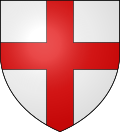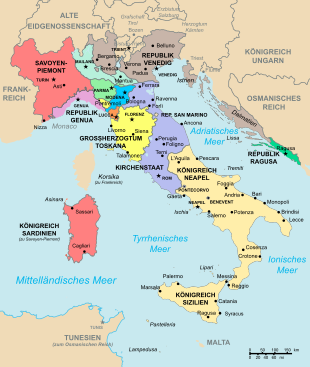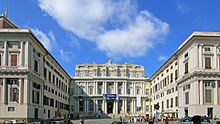Republic of Genoa
| Serenissima Repubblica di Genova | |||||
| Most Serene Republic of Genoa | |||||
| 958-1797 | |||||
|
|||||
| Capital | Genoa | ||||
| Form of government | Aristocratic Republic | ||||
| population | approx. 400,000 | ||||
| Political borders 1796 | |||||
The Republic of Genoa ( Italian Serenissima Repubblica di Genova ; German Serene Republic of Genoa ) was an aristocratic republic in what is now Italy , which became the Ligurian Republic on June 14, 1797 , a subsidiary of the First French Republic . The city of Genoa gained independence in the Holy Roman Empire as early as the 10th century .
Genoa was considered a trading sea power and enjoyed the reputation as the "gateway to the whole world". The city was also a colonial power and one of the four most famous maritime republics in Italy. Genoese merchants made their greatest profits from trading grain and slaves . While the slave trade was revived as a legacy of the Roman economic world and slaves represented an economic good of great value, the grain trade was the main source of food for the republic. Other important goods were spices , wax , furs , salt , fish , caviar and nuts .
history
In 774 the city of Genoa , which had previously belonged to the Lombards , fell to the Carolingian Frankish Empire . Since the end of Carolingian rule in Italy in 887, Genoa has been repeatedly invaded by Arabs ( Saracens ). At this time Genoa developed a certain degree of independence and became a republic with consuls at its head, but there was no real constitution. In 936 the city was able to defend itself against the sacking Saracens. In 958 Berengar II of Italy formally recognized Genoa.
On the side of Pisa , Genoa succeeded in driving the Arabs from Sardinia in 1017 . Both cities carried out several joint campaigns.
Already a maritime power at that time, Genoa was able to support the crusaders in 1097 and 1104 and expanded its influence on land and at sea. Through maritime trade, through its factories (trading posts) abroad and through its colonies, Genoa quickly acquired wealth and power.
However, as Pisa also grew into a maritime power (it conquered Corsica in 1070 ), war broke out in 1119, which the Pope finally ended in 1133 in favor of Genoa. A year earlier, Genoa had conquered northern Corsica. The diocese of Genoa became the Archdiocese of Genoa and was no longer under the Archdiocese of Milan .
Since there were internal conflicts in Genoa (e.g. disagreements between the noble families and differences between the Guelphs and Ghibellines ), other states repeatedly exercised considerable influence on the republic.
In 1261, based on the agreement of Nymphaion with the regaining Byzantium , the Genoese founded branches on the Black Sea, which opened up trade with China and India via the Mongol Empire, in Trebizond , Amastri , Vicina in the Danube Delta , Kilia , Kaffa , Cetatea Albă , Tana at the mouth of the Don and Phocea in the Aegean Sea. The Genoese traded, among other things, with slaves that were acquired from the Mongol Empire. Byzantium succumbed to the attack of Venice in the 4th Crusade in 1204, was replaced by the Latin Empire and was renewed in 1261 with the help of Genoa.
In the 12th and 13th centuries Genoa was at the zenith of its power. When Pisa tried in 1282 to take over the entire administration and economic exploitation of Corsica, this was the casus belli for the two republics. Genoa equipped 120 galleys and hired over 15,000 soldiers. After battles at Porto Torres and Sassari in Sardinia, it was finally able to defeat Pisa in the sea battle at Meloria on August 6, 1284. The Genoese victory meant the end of Pisa's naval and colonial power. Genoa also took over the south of Corsica and now had a great influence on the western Mediterranean. In 1290 it supported the Ilkhan in the Black Sea at sea. However, conflicts soon arose with the Republic of Venice . On September 8, 1298, Venice was initially defeated in the sea battle at Curzola . After a defeat in the Chioggia War in 1381, Genoa made peace with Venice.
Meanwhile the Genoese settlements along the Black Sea coast flourished. During their long presence there, merchants made their way deep into the hinterland and into the trading centers. They advanced up the Danube to the Iron Gate . A document from the Hungarian King Louis the Great has come down to us from 1349 , in which Genoese merchants are granted free trade along the Danube as far as Temesvár . The Genoese merchants also reached Kiev , Tabriz , Bolgar , Kazan , Abkhazia , Circassia in the Caucasus and, after 1315, India via their bases in the Black Sea region . It is reported that they advanced to Zeitun in China in 1322 and Kulam in India in 1338. The first Chinese silk appeared on Genoese markets as early as 1257.
In addition to the prestige product silk , it was mainly slaves and grain from the Black Sea region that were delivered to Genoa. It was in these two lines of business that the greatest volume of trade was achieved, and the Genoese island of Chios in the Aegean Sea became the largest slave market in the Mediterranean. Under the Genoese, the Black Sea region was the most important source of the slave trade after North Africa . The good business situation in the Black Sea region even made it possible to set up banks. Notarial files from 1360 and 1361 report on three banks in the port city of Kilia.
The continued presence of the Genoese in the Aegean and Pera and their usefulness for the Ottomans led to close economic contacts with the sultans. In 1387 the Genoese were able to conclude a trade agreement with Sultan Murad I , the content of which has been handed down in detail. It contained provisions on the freedom of trade for the Genoese, the treatment of runaway slaves, and the taxes the Genoese had to pay. In addition, the Ottomans were interested in working with the Genoese, as they used Genoese ships when they needed them because they did not have their own fleet.
In 1396 the French king temporarily took control of Genoa.
In 1435 Genoa succeeded in defeating the Kingdom of Aragon in a sea battle and capturing King Alfonso V.
Andrea Doria reformed the state in 1528 and gave it a new constitution. He also placed him under the protection of the Holy Roman Empire, thereby breaking the hegemony of France and Spain in Genoa. However, Giovanni Luigi de Fieschi tried to restore French influence in 1547. Friedrich Schiller processed this event in the play The Fiesco Conspiracy in Genoa .
Nevertheless, the internal disagreements gradually led to the loss of many colonies.
In 1684, Genoa was bombarded by French ships. In 1743 the Austrians occupied the city for a short time, but were driven out - allegedly by a stone's throw from the boy Giovan Battista Perasso .
As the last colony of Genoa, Corsica, which had been virtually independent since the Corsican uprising under Pascal Paoli in 1755, was sold to France in 1768. The sale of these nonetheless upheld claims to Corsica is therefore questionable.
In 1796 Napoleon Bonaparte occupied Genoa and a year later founded the Ligurian Republic . The occupation of the city by British naval forces offered the opportunity to proclaim the Republic of Genoa on April 20, 1814 , which was then united with the Kingdom of Sardinia a little later by the Congress of Vienna . The Genoese Provisional Government had to dissolve itself with a resolution of December 26, 1814.
Political system and its change
In the early days of the Republic of Genoa, the nobility, who had the greatest fortune and dominated the military, determined political events. From the 12th century onwards, the people were divided into six companies and were now allowed to choose military leaders, officials and judges. Because noble voices were more valid, however, a nobility of officials was formed. The common people were excluded from state affairs. The great council (consiglio) had almost only members of noble origin.
The highest office of the state was initially held by a consul. Later the leader of the state was called Podestà . Around 1260 Guglielmo Boccanegra was the leader of Genoa as Capitano del Popolo for a few years before the city returned to the Podestà system.
In 1339 Simone Boccanegra became Genoa's first doge . In parallel with the introduction of the Doge's office, the political system was changed. The Doges usually had rather limited powers over the nobility. However, half of the important offices were awarded by the people.
In 1353 the Archbishop of Milan, Giovanni Visconti , became ruler of Genoa. A few years later, however, the Doge's office went back to Boccanegra, who now had all offices awarded by the people.
In 1396 the French king was offered rule. There were several attempts to overthrow French suzerainty, which finally succeeded in 1409. Later, France briefly took control of Genoa again. Now a council of nobility, people, Ghibellines and Guelphs was installed. Genoa was later controlled by other powers.
The Banco di San Giorgio , founded in 1407 , also had a significant influence in Genoa . It was closely linked to the state and also controlled parts of the colonies.
Since Andrea Doria's reforms around 1528, the Great and Small Councils as well as the Doge have each been elected for two years.
Significant personalities and buildings
The most important patrician families were based on one of the countries France, Naples, Milan and Spain. Some of these families came from the ministerial aristocracy , a few also old noble-free vice counts (Spinola, Grillo), others from the commercial middle class. Among the most powerful families were the Doria and Spinola (both supported the emperor in conflicts with the Pope), the Fieschi (based on the Kingdom of Naples ), the Grimaldi (still rule Monaco today , like the Fieschi supported the Pope) and the Cattaneo, Centurione, Di Negro, Giustiniani, Grillo, Imperiali , Lercari, Negrone, Pallavicino. As in other northern Italian cities, the more powerful patrician families gathered around them as supporters of less important families and thus formed an albergo . In 1528 there were 28 Alberghi in Genoa . However, the count houses ruling in neighboring Liguria, such as the Malaspina or Ventimiglia, also influenced the politics of the republic.
The Genoese navigator Christopher Columbus discovered America while serving in Spain. The musician and composer Niccolò Paganini was also born in Genoa.
At the time of the Genoese Republic, many palaces were built, including the Doge's Palace (Palazzo Ducale). Among other things, the lighthouse of Genoa was built during this time and the University of Genoa was founded.
Colonies
Colonies of Genoa included Corsica, northern Sardinia and parts of Cyprus . There were others on the Black Sea and in the Aegean Sea . Monaco was disputed between Genoa and the Genoese Grimaldi family. It eventually fell to the Grimaldis. In addition, there were several bases, e.g. B. on the African coast.
See also
literature
- Matthias Schnettger : “Principe sovrano” or “Civitas imperialis”? The Republic of Genoa and the Old Kingdom in the Early Modern Period. (1556–1797) (= publications of the Institute for European History, Mainz. Volume 209 = contributions to the social and constitutional history of the Old Kingdom. Volume 17). von Zabern, Mainz 2006, ISBN 3-8053-3588-1 (also: Frankfurt am Main, University, habilitation paper, 2005).
- Matthias Schnettger, Carlo Taviani (ed.): Libertà e dominio. Il sistema politico genovese. Le relazioni esterne e il controllo del territorio (= Ricerche dell'Istituto Storico Germanico di Roma. Volume 6). Viella, Rome 2011, ISBN 978-88-8334-477-0 .
- Manfred Pittioni: Genoa - the hidden world power. 1000–1700 (= expansion, interaction, acculturation. Volume 19). Mandelbaum-Verlag, Vienna 2011, ISBN 978-3-85476-349-9 .
- Alessia Ceccarelli: Tra sovranità e imperialità. Genova nell'età delle congiure popolari barocche (1623–1637). In: Sources and research from Italian archives and libraries . 93, 2013, pp. 251-282 ( perspectivia.net ).
- The Republic of Genoa. In: Conversations Lexicon. (in six volumes) Volume 2: F – L. Brockhaus, Amsterdam 1809, pp. 92–93 ( zeno.org ) and pp. 459–460 ( zeno.org ).
- The Republic of Genoa. In: Conversations Lexicon. (Supplements, first volume) Volume 7: A – L. Brockhaus, Amsterdam 1809, pp. 387-388 ( zeno.org ).
- Genoa (history) . In: Meyers Konversations-Lexikon . 4th edition. Volume 7, Verlag des Bibliographisches Institut, Leipzig / Vienna 1885–1892, p. 119.
Web links
- flaggenlexikon.de with a tabular history of Genoa
Individual evidence
- ↑ Bernd Roeck: The morning of the world . 1st edition. CH Beck, 2017, ISBN 978-3-8031-2558-3 , pp. 207 .
- ↑ a b Manfred Pittioni: Genoa - the hidden world power. 2011, pp. 48-49.
- ↑ Bernd Roeck: The morning of the world . 1st edition. CH Beck, 2017, ISBN 978-3-8031-2558-3 , pp. 322 .
- ↑ a b Manfred Pittioni: Genoa - the hidden world power. 2011, pp. 56-57.
- ↑ a b Manfred Pittioni: Genoa - the hidden world power. 2011, pp. 69-72.
- ^ Andreas Doria in the Brockhaus from 1809







